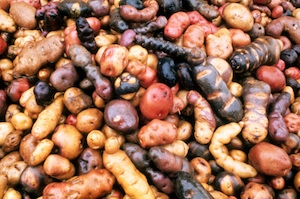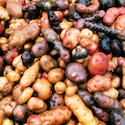GoodFood World Opinion:
Organizations ranging in size from local native plant associations to the international groups like the Nature Conservancy are focused on protecting endangered plant species and threatened habitats. Millions of dollars a year are spent on projects to protect endangered plants – from giant California redwoods to the tiny Marsh Sandwort – but less is spent to protect plants used for food.
As a result we fail to consider the importance of wild and domesticated food plants. Consumers in the developed world eat from a smaller and smaller selection of carefully bred and often genetically modified food crops.

Between 1900 and 2000, 75% of crop diversity was lost; industrial agriculture focuses on the development and output of only a few major crops. That same narrow focus means that as much as 22% of the wild relatives of peanuts, potatoes, and beans will disappear by 2055 as a result of climate change.
The UN’s Food And Agricultural Organization (FAO) has released a new report addressing the potential loss of genetic diversity of food plants, domestic and wild.
Press announcement from the UN Food and Agriculture Organization (FAO):
Rome, Italy – The genetic diversity of the plants that we grow and eat and their “wild relatives” could be lost forever, threatening future food security, unless special efforts are stepped up to not only conserve but also utilize them, especially in developing countries.
This is one of the key messages of the second report on The State of the World’s Plant Genetic Resources for Food and Agriculture, launched today by FAO.
The 350-page report, which covers everything from gene bank collections to the effects of climate change on crop diversity, is the definitive health check on what is being done to protect biodiversity in food and agriculture crops.
The loss of biodiversity will have a major impact on the ability of humankind to feed itself in the future, all nine billion of us by 2050, with the poorest in the world most affected.
Climate change
Genetic information held in certain crop varieties is crucial to the development of heat, drought, salinity, pests and diseases-resistant, fast-growing, high-yielding new varieties, necessary to combat food insecurity in the face of climate change.
“Increasing the sustainable use of plant diversity could be the main key for addressing risks to genetic resources for agriculture,” said Diouf.
“There are thousands of crop wild relatives that still need to be collected, studied and documented because they hold genetic secrets that enable them to resist heat, droughts, salinity, floods and pests.”
Fifty percent of the increase in crop yields in recent years has come from new seed varieties. Irrigation and fertilizer account for the other 50 percent. A recent good example is the fast-maturing New Rice for Africa (NERICA) that has transformed local economies in several parts of Africa.
Wild relatives
More needs to be done, especially at the level of the farmer’s field, generating local interest, and building capacities to conserve and use the genetic biodiversity that still exists.
It has been twelve years since the first State of the World’s Plant Genetic Resources for Food and Agriculture was published and in that time the global food landscape has changed drastically.
Hunger has been reduced in some countries, but has risen in others. Fuel and food prices have increased substantially. Globalization has widened and deepened, and cheap food imports in some countries have threatened the richness of local diversity.
Although the report does not attempt to quantify biodiversity loss, empirical evidence points to the continued extinction of crop biodiversity whittling away at the diversity of traditional food crops that survived the last century.
FAO estimates 75 percent of crop diversity was lost between 1900 and 2000. A recent study, highlighted in the State of the World’s Plant Genetic Resources for Food and Agriculture, predicts that as much as 22 percent of the wild relatives of important food crops of peanut, potato and beans will disappear by 2055 because of a changing climate.
Gene banks grow
On a more positive note, the report states that over the past twelve years, there has been an increase in awareness of the importance of protecting and utilizing the genetic diversity of food crops. Gene banks have increased in both size and the number.
There are now some 1 750 gene banks worldwide, with about 130 of them each holding more than 10 000 accessions. And in 2008, the ultimate back-up of global crop diversity, the Svalbald Global Seed Vault, opened in Norway.
Of the total 7.4 million samples conserved worldwide, national government gene banks conserve about 6.6 million, 45 percent of which is held in only seven countries, down from twelve countries in 1996.
This increasing concentration of collected and preserved genetic diversity in fewer countries and research centers highlights the importance of mechanisms to ensure facilitated access such as that provided by the International Treaty for Plant Genetic Resources for Food and Agriculture, of FAO.
The Treaty, now ratified by 125 nations, sets out a framework for compensating poor farmers for preserving different genetic crop varieties.
Investment neglect
The neglect in investment in agriculture since 1980 has inevitably led to a shortage of qualified agricultural scientists including plant-breeders, especially in developing countries, as young people, lacking incentives, turn their sights to more immediately profitable activities, the report says.
Huge advances have been made in biology and information technologies over the past twelve years; benefits from these need to be extended to improve use of agro-biodiversity with the ultimate aim of improving food security.
Many seed systems, the market or mechanism by which quality seeds are reproduced, tested and distributed, have also broken down. In the developed world, the seed sector is profitable enough to make it a viable business interest.
Unfortunately, this is not the case in poor countries where public entities are struggling to ensure good seeds for all farmers and access to new varieties.
A broader and better use of genetic resources and biodiversity in food crops will stimulate conservation. But adequate systems need to be in place to get new varieties into the hands of farmers both through the public sector and other players, the report found.

